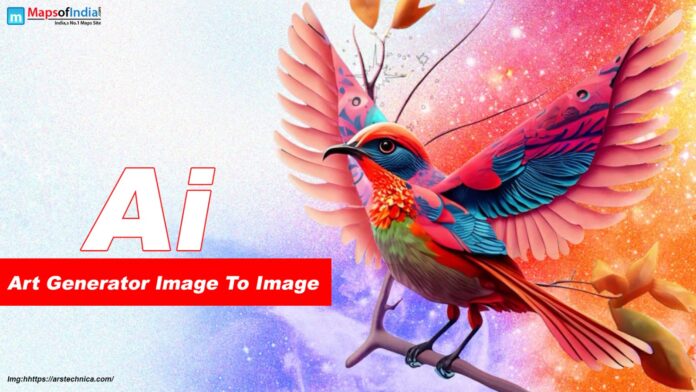AI Image-to-Image: Transform Your Visuals with AI Art Generators
Ever wondered what it would be like to turn a rough sketch into a stunning, lifelike image or take a regular photo and turn it into a dreamy, surreal piece of art? That’s exactly what AI Image-to-Image tools can do.
These AI art generators let you transform existing images into something completely new. You simply upload a picture, give the AI a bit of direction, and watch it bring your vision to life. Whether you’re an artist, designer, or just curious about creative tech, it’s easier than ever to create unique, eye-catching visuals.
AI Image-to-Image: Transform Your Visuals with AI Art Generators isn’t just a trend; it’s changing how we approach creativity. And the best part? You don’t need to be a pro to use it.
Just an idea, a spark, and a few clicks, and you’re creating something unforgettable.
How It Works: The Underlying Technology
Behind the scenes, some truly incredible stuff is at work in AI Image-to-Image: Change the Way You Look with AI Art Generators. The diffusion model and generative adversarial networks (GANs) are two of the most effective and popular techniques. Each contributes in a different way to AI’s ability to produce extraordinarily realistic or imaginatively styled graphics.
Beginning with a look at diffusion models. These models operate ingeniously. They start by slowly adding a small amount of disturbance to an image until it is reduced to static. They then discover how to go backwards in that procedure. Based on your input or quick, the AI gradually eliminates the noise and reconstructs the image. It’s similar to seeing an old snapshot gradually come to life, molded by your creativity. Tools like Stable Diffusion, which enable accurate and adaptable image production, are particularly well-liked for using this technique.
Then there are Generative Adversarial Networks, or GANs for short. Two neural networks use an original “tug of war” to accomplish this. The generator is one network that attempts to produce new images. The other, known as the discriminator, determines if such pictures are authentic or not. As the generator becomes more adept at tricking the discriminator, the AI begins to create images that are very similar to real pictures.
Use Cases: Unleashing the Potential of AI Image Transformation
AI image transformation has a lot of cool uses! Let’s explore a few of them.
Art and Design: Enhancing Creative Workflows
Artists are using AI to create concept art, generate textures, and try out different styles. It’s like having a super-fast prototyping tool. This can significantly speed up their workflow. They can quickly visualize ideas and explore different options before investing time in manual creation.
Photography: Editing, Restoration, and Style Transfer
AI-powered tools can remove blemishes, boost resolution, and restore old photos. They can also apply artistic filters to give photos a unique look. You can easily fix blurry areas, brighten colors, and even add details that were originally missing.
E-commerce and Marketing: Product Visualization
AI can generate different versions of product images, create lifestyle scenes, and customize visuals for different shoppers. Imagine showing a couch in various colors and room settings without actually photographing them. It can personalize marketing visuals to appeal to specific customer groups.
Choosing the Right AI Image-to-Image Generator
With so many AI tools out there, it can be a bit overwhelming to figure out which AI image-to-image generator is the right fit for your needs. The good news? There’s something for everyone—whether you’re an artist, designer, content creator, or just experimenting for fun.
Here are a few key things to consider when choosing the right tool:
1. Ease of Use
If you’re new to AI art, go for a tool with a simple interface and beginner-friendly features. Some platforms let you drag and drop images or use preset styles—no technical skills required.
2. Creative Control
Some tools give you more freedom to tweak the output. Look for features like prompt-based editing, brush tools, or style sliders if you want more customization.
3. Image Quality
Not all AI generators produce the same level of detail. If you need high-resolution, photorealistic results (for professional work, prints, or branding), check whether the platform supports HD outputs and fine details.
4. Speed & Performance
Some generators work in seconds, while others take longer but offer more control. If you’re working on tight deadlines or just want quick results, choose a tool that balances speed and quality.
5. Style Options
Each tool has its own artistic vibe. Some are better at anime or cartoon styles, while others excel at realism or fantasy. Try a few and see which one matches your creative vision.
6. Cost & Access
Many platforms offer free trials or limited-use versions. But for high-quality, consistent output, you might need a paid plan. Make sure the pricing fits your budget and creative needs.
The Future of AI Image-to-Image
AI image generation is only going to get better. What’s on the horizon?
Emerging Trends and Technologies
AI models are constantly improving, creating more realistic and detailed images. New creative options are always being developed. You might soon see AI that can generate 3D models or even animated videos from a single image.
Ethical Considerations: Copyright and Ownership
Who owns AI-generated art? This is a big question. Copyright laws are still catching up.
AI will continue to change the roles of artists and designers. It might handle some of the more time-consuming tasks, freeing up creatives to focus on the big ideas. AI will become a valuable tool for creative expression.
Conclusion
AI image-to-image generation offers a powerful way to transform your visuals. It’s getting easier to use and offers endless creative possibilities. So, dive in and experiment with these tools. You might surprise yourself with what you can create. AI has the potential to change creativity.




